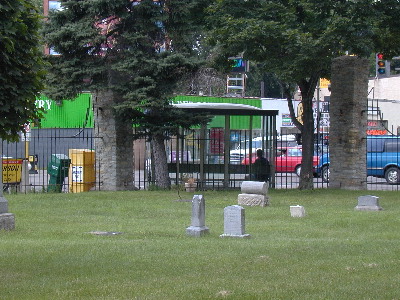 |
Minneapolis Pioneers and Soldiers Memorial Cemetery History Page Alley Article |
| Home | Burial Search | Friends | History | Photo Gallery | Visitor Information |
| Alley Articles |
|
This article originally appeared in the Phillips community's Alley Newspaper, September 2003. Minneapolis Pioneers and Soldiers Memorial Cemetery Every day tens of thousands of commuters pass through the intersection of Cedar Avenue and Lake Street. Most of them are unaware of the fact that they are within several feet of a major historic site. In June 2002, Minneapolis Pioneers and Soldiers Memorial Cemetery was placed on the National Register of Historic Places. Although Minneapolis Pioneers and Soldiers Memorial Cemetery is the oldest existing cemetery in Minneapolis, that was not sufficient reason for its inclusion on the Register. In fact, federal historic designation is an honor that is rarely awarded to cemeteries since any cemetery is, by definition, “historic.” So why does this cemetery merit such an honor? The cemetery was awarded its historic designation because of the role that those buried in the cemetery played in the early days of Minneapolis’ history. As its name suggests there are a number of Minnesota territorial pioneers buried there, as well as approximately 200 military veterans. Three veterans of the War of 1812 are buried at Minneapolis Pioneers and Soldiers, as are approximately 150 Civil War veterans. Other veterans served in the Mexican-American and Spanish-American wars. The cemetery has strong ties to Minneapolis’ abolitionist movement of the 1850’s and 60’s and has been racially integrated since at least the 1860’s, a practice that was not common at that time. However, veterans and territorial pioneers (i.e., those who lived in Minnesota before 1858) make up only a small percentage of the 17,000 people buried there. The majority of people were working class--the people who, quite literally, built the city of Minneapolis. These include hundreds of people who worked in the flour and milling industries, and who built or worked for the railroads. There are several thousand immigrants buried in Minneapolis Pioneers and Soldiers. Children make up the largest group; an estimated 50-60% of the people buried in the cemetery are children under the age of ten. The first burial took place in 1853 making this the cemetery’s 150th anniversary year. In recognition of that, the cemetery was selected as this year’s regional Arbor Day planting site. The theme was “Renewing Our Legacy: 150 Trees for 150 Years.” Approximately 200 volunteers turned out to plant, mulch and water the trees which were specially selected to increase species diversity and to provide wildlife habitat. Most of the trees were planted according to a design developed by Works Progress Administration employees during the 1930’s. More than sixty years after it was developed, a collaboration among numerous city agencies and non-profit organizations brought the plan to completion. The cemetery has been owned and maintained by the City of Minneapolis since 1928. It is open Wednesday-Sunday from 8:00-4:30 between April 15 and October 15. The next time you’re in the neighborhood and have a few extra minutes, think about stopping in and paying your respects to some very interesting people. Friends of the Cemetery, a volunteer organization dedicated to the preservation and restoration of the cemetery, offers tours and speakers on request. If you are interested, contact Dorothy at the Corcoran Neighborhood Organization (612)724-7457 or e-mail friends@friendsofthecemetery.org.
Next Article -> Iron Crosses -- November 2003 |
|
©Friends of the Cemetery, 2005-2008 Contact us at history@friendsofthecemetery.org |
File last updated: Saturday June 14, 2008 |
